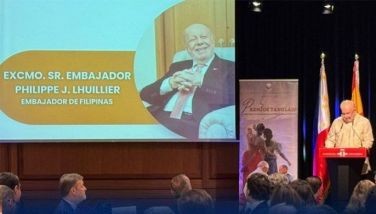Frasco’s gastronomy dream


Tourism Secretary Christina Garcia Frasco is determined to put the Philippines on the global gastronomy destination map following her joint effort with the United Nations Tourism this week in hosting the First Regional Gastronomy Tourism for Asia and the Pacific Forum in her home province of Cebu, with almost 600 delegates attending from 43 countries including member countries from as far away as Afghanistan, Argentina, Cameroon, Chile, Fiji, Germany, Iran, Mongolia, the United Arab Emirates and our ASEAN neighbors, China and Japan to name a few.
It was quite clear on Wednesday when the forum opened that Secretary Frasco is a great tourism promoter of her own home province, showcasing Cebu’s culture through songs and dance, as well as Cebuano cuisine and other regional food offerings from all regions – from Luzon – the Ilocos, Pampanga, Calabarzon, Visayas and Mindanao.
In her opening speech, Secretary Frasco pointed out that food tourism is a growing and dynamic sector that offers enormous potential for economic growth and advancement. The UN Tourism Regional Forum on Gastronomy Tourism for Asian and the Pacific, she said, “will not only elevate the Philippines as a gastronomic destination, but also provide a platform for collaboration and exchange of knowledge among international culinary experts.”
According to Frasco, “Filipino cuisine is a diverse tapestry of flavors, reflecting regional characteristics from across our beautiful archipelago of 7,641 islands, from the globally renowned Cebu lechon and the comforting tastes of adobo and , to Mindanao’s distinctive dishes like curacha (and) pastil. Our culinary heritage is rich and varied...with delicacies such as balut...halo-halo...and leche flan. Through our food, we tell the story of the Filipino.”
She acknowledged that the Philippines is “deeply honored by the confidence conferred upon our nation by the UN Tourism and its member states to host the inaugural global event that brings together ministers, heads of delegations, heads of missions, experts, stakeholders, enthusiasts from over 40 countries from around the world and Asia Pacific to celebrate gastronomy, to develop and promote tourism and to cultivate the symbiotic relationship of these two sectors that assures our mutual success.”
Frasco said earlier that as the Philippines “ushers in this golden era of tourism under the leadership of President Marcos, we embrace the opportunity to showcase the Philippines to the world.”
Leaving a legacy
UN Tourism Organization Secretary-General Zurab Pololikashvili, for his part, expressed his appreciation for Filipino food, noting that unless one knows a Filipino diplomat or has a Filipino friend, it is quite difficult to find a Filipino restaurant abroad, thus the need to promote Filipino food. He also admitted that he himself had dreams of also becoming a chef.
However, Pololikashvili cited the need to learn the methodology and educate Filipinos on how to become a gastronomy destination. Thus, he expressed his desire to leave a legacy through a proposal to establish an educational gastronomy center in Cebu, a proposal that Secretary Frasco boldly welcomed and assured support for, even as financing for the possible education center would still have to be formally discussed by the UN Tourism body, the Philippine government and other institutions that would help in teaching the technical skills, such as the Basque Culinary Center that was represented during the Cebu forum by by Idoia Calleja.
The UNTO Secretary-General admitted though that any decision on financing an educational gastronomy center, not only in the Philippines or elsewhere for that matter, would of course eventually fall on the Minister of Finance who would decide on the allocation of funding for such an endeavor.
Calleja, in her own speech, pointed out that gastronomy “is one of the sectors that show the way of life.” She elaborated further that “when we travel, we like to discover the local cuisines, destinations, restaurants, the taste, products, traditions and to be able to have an authentic experience.”
UN Tourism ambassador and well known chef Margarita Fores expressed her support for Frasco’s move to make the Philippines a destination for gastronomy tourism, a goal that she herself had started embarking on in the early 2000s as she collaborated with the Department of Agriculture to attend several international events such as the Slow Food Terra Madre, Indentita Golose, Food on the Edge and the Madrid Fusion where she proudly shared Philippine cuisine, and her participation in the 23rd UNTO General Assembly in Bhutan.
Those experiences, Fores said, gave her the chance to connect with Filipino farmers and artisans from all over the country, “discovering the richness of the produce, culture and heritage.” Gastronomy tourism, according to Fores, is a fast growing trend with more travelers wanting to explore the world, not only by visiting and seeing museums, churches and ruins, but by “also sampling local dishes, taking cooking classes, or even going on farm excursions.”
However, Fores emphasized that gastronomy tourism “has the potential to significantly benefit rural communities, especially those rich in local traditions,” citing that tourists spend on food, accommodations and various activities, which injects funds into local communities. Likewise, she said, gastronomy is also a cultural bridge that “celebrates centuries old recipes, local ingredients and culinary traditions, preserving and enriching cultural heritage for future generations.”
Fores, in her speech, also highlighted the need to approach gastronomy tourism with sustainability in mind, as well as putting in place environment-friendly protocols. She warned against “over-commercialization and irresponsible tourism which can dilute traditional dishes, corrupt traditions and strain infrastructure.”
Thus, she called for the support of everyone, “not just the hospitality and tourism sectors,”but also the involvement of the local communities and government.
Her recommendation, thus, is “build better infrastructure, educate local chefs and food producers, respect tradition, communities and the environment.”
A roster of Filipino chefs
As part of the one-day forum, Secretary Frasco showcased Philippine cuisine for dinner with the help of renowned Filipino chefs that included Fores, Miko Calo, Jessie Sincioco, Reggie Aspiras, Sau del Rosario, Miko Aspirals, Thirdy Dolatre and John Kevin Navoa of Hapag, Carlos Villaflor of Gallery by Chele, Tatung Sarthou of Lore, Aaron Isip of Kasa Palma, Miguel Moreno of Palm Grill, also Mindanao chef Datu Shariff Pendatun III who showcased the cuisine of Mindanao.
The cocktail style lunch featured regional dishes from the Cordillera Administrative Region and from Regions 1 to 12 and featured up and coming chefs.
Following the regional tourism forum, delegates were treated to tours in Camotes Island, Argao and Dalaguete.
Today, the 36th UN Tourism Joint Commission Meeting for East Asia and Pacific and South Asia will be held at the Sheraton Mactan with no less than President Marcos attending the meeting.
- Latest
- Trending




























